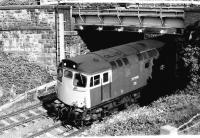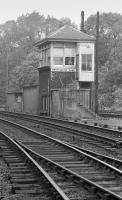Edinburgh, Suburban and Southside Junction Railway
Introduction
This line is open to freight. It provided a circular route for passenger trains serving the south of Edinburgh and an Edinburgh Waverley bypass for trains from the east to west. Niddrie Yard developed near its east end amongst the Niddrie Junctions.
Dates
Portions of line and locations
This line is divided into a number of portions.
Haymarket to Duddingston
This runs east from Haymarket West Junction to Duddingston Junction through the south side of Edinburgh. This allowed goods and mineral trains to bypass Edinburgh Waverley and allowed an approach to South Leith from the west. It also carried a circular passenger service based on Edinburgh Waverley and often terminating at Leith Central. Duddingston Junction to Niddrie West Junction was doubled.
This junction opened in 1876 when the Wester Dalry Branch and Dalry Road Lines (Caledonian Railway) opened, allowing Caledonian Railway trains from Edinburgh Princes Street to join the Edinburgh and Glasgow Railway westbound and then, via the Stirlingshire Midland Junction Railway, join the Scottish Central Railway at Larbert Junction and run north to Stirling, ...
More detailsSee also
Edinburgh and Glasgow Railway
Corstorphine Branch (North British Railway)
Wester Dalry Branch and Dalry Road Lines (Caledonian Railway)
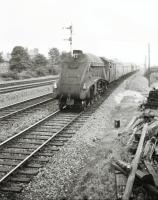
David Murray-Smith 14/08/1961
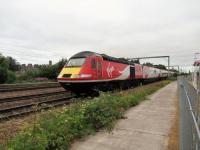
David Panton 16/07/2018
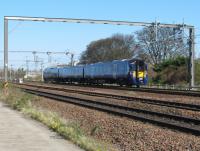
David Panton 13/04/2019
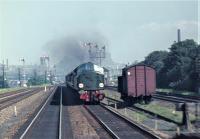
Brian Haslehust //1963
This is the southern junction of a triangular junction formed by Haymarket West Junction (west), Haymarket Central Junction (east) and Gorgie Junction (south).
...
See also
Gorgie Cattle Market Branch (North British Railway)

Bill Roberton //1975
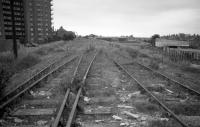
Bill Roberton //1975

John Furnevel 14/04/1981
This mill was rail served via a headshunt from Gorgie Junction. It was the glue and gelatine mill of J&G Cox Ltd, originally the site was probably a corn mill. The mill was rail served from 1905.
...
See also
Gorgie Cattle Market Branch (North British Railway)
This was a small goods yard on the west side of the line just north of Gorgie station and south of Gorgie Junction. It was approached from the north. On the west side of the yard was Gorgie East Minerals, a larger set of sidings for coal traffic. Further west again was the start of the Gorgie Cattle Market [NB], which crossed over a level crossing (as did the mineral yard ...
More detailsSee also
Gorgie Cattle Market Branch (North British Railway)

David Panton 13/01/2019

Frank Spaven Collection (Courtesy David Spaven) //1961

Frank Spaven Collection (Courtesy David Spaven) //1961

Frank Spaven Collection (Courtesy David Spaven) //1961
This was a two platform station. Nothing remains of the station.
...

David Bosher 18/06/2022

David Bosher 20/07/2017

Robin McGregor 16/10/1965

David Panton 12/11/2018
This was a temporary station for the Edinburgh International Exhibition of 1890 for Electrical Engineering, General Inventions and Industries. It was built in the cutting to the east of the exhibition. The site was also served by Exhibition [CR].
...
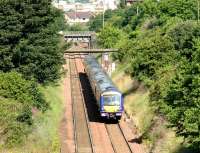
John Furnevel 16/07/2006
This double track junction is between the 1884 Edinburgh, Suburban and Southside Junction Railway and the Slateford to Craiglockhart Curve (British Railways).
...

...
Bill Roberton //1982

...
Bill Roberton //1982

Bill Roberton 27/08/2019

John Furnevel 27/08/2017
This was a two platform station in a deep cutting to the south of Colinton Road and the Union Canal. There were waiting rooms at platform level. The station had no goods yard.
...

John Furnevel 23/02/2002
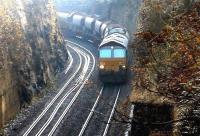
John Furnevel 06/10/2003

John Furnevel 06/10/2003
This was a two platform station. It is fairly intact despite closure in 1962. The eastbound platform and street level ticket office both remain intact. A lattice footbridge still crosses the west end of the former station.
...

Charlie Niven 14/05/2022
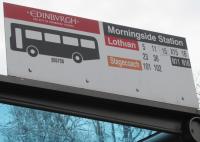
David Panton 26/12/2019

Douglas Blades 21/06/2021
This was a two platform station to the west of Blackford Avenue.
...

...
Bill Roberton //1977

John Furnevel 12/04/2002

Charlie Niven 21/09/2018

Bill Roberton //1986
Newington Goods was west of Newington, Newington Stone Yard being a little further west. Both were on the north side of the line and served from the west.
...

Bill Roberton //1974

Charlie Niven /07/1989

Bill Jamieson 17/04/1970

Bill Roberton //1974
This was an island platform station. The island was accessed by steps down from Mayfield Gardens/Craigmillar Park at the east end and by a footbridge and path on the north side of the line which ran to Mayfield Road to the west. The station building on the platform was originally fitted with canopies.
...

...
Bill Roberton 16/12/2023
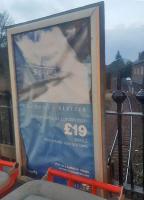
Ewan Crawford Collection 14/01/2017

Bill Roberton 30/04/2019

Ewan Crawford Collection 14/01/2017
This signal box was east of Newington [NBR] station at Cameron Toll where the line runs raised on an embankment. It was relatively short lived, lasting from 1900 to 1925. The line remains open.
...

John Furnevel 28/12/2019

John Furnevel 27/12/2019

John Furnevel 27/12/2019

John Furnevel 28/12/2019

John Furnevel 06/08/2017

John Furnevel 28/03/2007
This was a two platform station on a curve. It was immediately to the west of Duddingston Junction. The main station building was on the eastbound platform with a smaller on the westbound. A goods yard was to the north, served from the old Edinburgh and Dalkeith Railway line, rather than the new Edinburgh, Suburban and Southside Junction Railway on which the station was located.
...

John Furnevel 28/12/2019

John Clark 31/12/1968

Bill Roberton //1989

John Furnevel 28/12/2019
This junction was directly east of Duddingston station. It was formed in 1884 between the 1831 Edinburgh and Dalkeith Railway and the Edinburgh, Suburban and Southside Junction Railway.
...
See also
Edinburgh and Dalkeith Railway

...
Bill Jamieson 04/02/1970
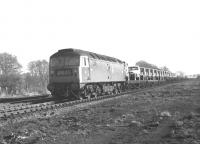
...
Bill Jamieson 04/02/1970
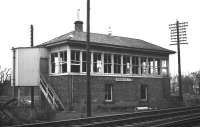
...
Bill Jamieson //1969
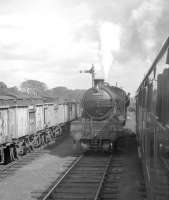
R Sillitto/A Renfrew Collection (Courtesy Bruce McCartney) 25/08/1962
Haymarket Curve
This curve runs from Haymarket Central Junction to Gorgie Junction. This allowed a circular passenger service based on Edinburgh Waverley and often terminating at Leith Central.
This junction is west of Haymarket station and Haymarket East Junction. The junction opened with the Edinburgh, Suburban and Southside Junction Railway junction in 1884.
...
See also
Edinburgh and Glasgow Railway
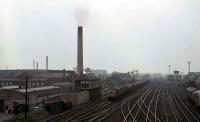
John Clark //1971
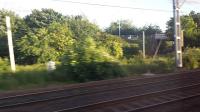
Charlie Niven 20/06/2016
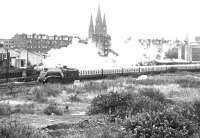
John Furnevel 01/09/1979
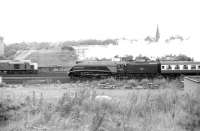
John Furnevel 01/09/1979
This is the southern junction of a triangular junction formed by Haymarket West Junction (west), Haymarket Central Junction (east) and Gorgie Junction (south).
...
See also
Gorgie Cattle Market Branch (North British Railway)

Bill Roberton //1975

Bill Roberton //1975

John Furnevel 14/04/1981
Niddrie Curve
This curve runs from Niddrie West Junction to Niddrie North Junction. This allowed a circular passenger service based on Edinburgh Waverley and often terminating at Leith Central.
This junction is between the single track line from Portobello East Junction and the double track from Niddrie South Junction. The line runs west to Craiglockhart Junction round the Edinburgh Suburban line (the former Edinburgh, Suburban and Southside Junction Railway).
...
See also
Edinburgh and Dalkeith Railway
Lothian Lines (North British Railway)

John Furnevel 01/07/2018
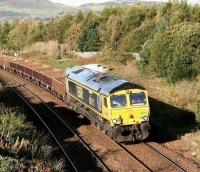
John Furnevel 15/10/2017
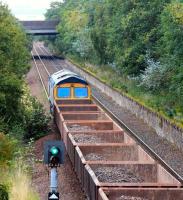
John Furnevel 10/09/2017
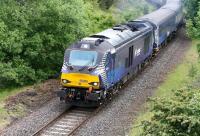
John Furnevel 11/08/2019
This was the junction between the North British Railway's line from Portobello East Junction to Niddrie South Junction and an isolated curve of the Edinburgh, Suburban and Southside Junction Railway from Niddrie West Junction which enabled trains from the southside line to approach Edinburgh Waverley from the east, thus completing a circle line and provide a route for goods ...
More detailsSee also
Edinburgh and Hawick Railway (North British Railway)
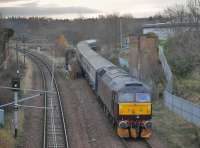
Bill Roberton 29/11/2023
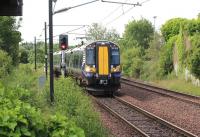
John Furnevel 08/07/2018
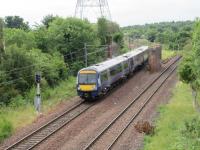
David Panton 13/07/2018

John Furnevel 15/09/2019
Niddrie West to East
This double track line ran from Niddrie West Junction to meet the original Fisherrow branch east of the Niddrie where it then used the trackbed for a short distance before diverting south to the North British Railway main line at Niddrie East Junction. This completed a triangular junction with the main line at the east end of the line.
This junction is between the single track line from Portobello East Junction and the double track from Niddrie South Junction. The line runs west to Craiglockhart Junction round the Edinburgh Suburban line (the former Edinburgh, Suburban and Southside Junction Railway).
...
See also
Edinburgh and Dalkeith Railway
Lothian Lines (North British Railway)

John Furnevel 01/07/2018

John Furnevel 15/10/2017

John Furnevel 10/09/2017

John Furnevel 11/08/2019
This junction opened in 1884. Also known as Newhailes East Junction. It was the southern end of a Edinburgh, Suburban and Southside Junction Railway curve connecting north west to the Fisherrow branch of the Edinburgh and Dalkeith Railway.
...
See also
North British Railway











